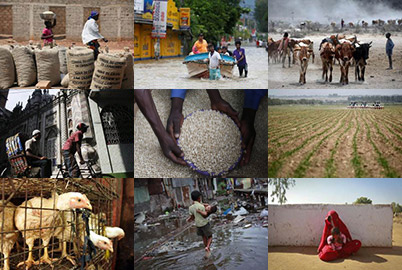By Fidelis Zvomuya
KHAYELITSHA TOWNSHIP, South Africa (AlertNet) - Five years ago, Nozipho Nodliwa's shack in this sprawling township on the outskirts of Cape Town caught fire and was destroyed.
She and 500 others, including children and disabled people, were left homeless, cold and destitute by the early morning blaze, which raced through an entire section of the informal settlement.
The fire, investigators later found, was started by a 30-year-old man who was drunk, wanted a warm bath and "left his paraffin stove unattended," Nodliwa, now 47, remembers.
Such fires are a perpetual threat in slums and informal settlements around the world, as people with no access to electricity turn to firewood, coal, paraffin or charcoal for heat and cooking.
But thanks to the Kyoto Protocol's Clean Development Mechanism (CDM), Nodliwa and 4,000 other families in Khayelitsha now have clean sources of heat and light as part of a project to reduce greenhouse gas emissions and improve the lives of vulnerable people.
Nodliwa, a mother of six who lost her husband to AIDS, was recently given a government-subsidized house with a solar water heater, ceiling insulation and compact fluorescent lightbulbs after becoming part of the SouthSouthNorth Projects Africa's (SSNA) Clean Development Mechanism effort in Kuyasa, a poor location in Khayelitsha township in Cape Town.
Nodliwa, who works as a domestic worker, had been worried she would not be able to afford the heating bills on her salary but the new home has brought huge energy cost savings, among other benefits.
"I have also seen an improvement in the thermal performance of my house, reducing the need for indoor heating with fuels such as paraffin, which cause respiratory problems and are a fire risk," she said.
"This was a severe challenge to families when trying to heat or cool our homes. The resulting condensation in the buildings also meant that we were living with up to three litres of water dripping on our belongings every day," Nodliwa said.
LESS DISEASE, FEWER FIRES
Carl Wesselink, the Kuyasa project manager who also works for the South African Export Development Fund, said a lack of proper ceilings and insulation meant families were spending around 10 South African rand ($1.40) a night to heat their homes in winter.
"The condensation and warm, damp conditions also proved a breeding ground for diseases, especially tuberculosis," Wesselink said.
Families have not only managed to cut their electricity costs by 35 percent a year, but are also doing their bit to reduce harmful greenhouse gas emissions, he added.
Each solar water heater reduces carbon dioxide emissions by about 1.29 metric tons per household per year; together the project heaters eliminate the amount of carbon dioxide emitted by an aeroplane flight of 12,200 kilometres (7,600 miles), say from Los Angeles to Cairo, Wesselink said.
The retrofitted buildings are 5 percent warmer in winter and 5 percent cooler in summer, allowing a saving of up to 40 percent on electricity bills, he added.
The buildings also reduce localised air pollution, helping prevent pulmonary pneumonia, carbon monoxide poisoning and other respiratory illnesses.
Another direct benefit is the decrease in the deadly fires common in high-density and low-income settlements.
PRIZE WINNING TOWNSHIP
In 2005, the Kuyasa CDM project was recognised at the Montreal climate change conference for its potential to reduce greenhouse gases and earn carbon credits, and in August last year it was awarded gold standard recognition by the United Nations Framework Convention on Climate Change (UNFCCC), allowing it to earn certified emission credits.
The CDM in the Kyoto Protocol allows developing countries to implement carbon reduction programmes, such as energy-saving projects, and convert them into carbon credits that can be traded.
The price of these credits is calculated according to the amount of CO2 saved.
"The market price is between $3 and $9 per ton," said Lester Malgas of SSNA. "But Kuyasa got $15 a ton from the UK government, because it is the first project in Africa, and because of its gold standard."
The project has already achieved a total of 6.5 tons of carbon reductions a year, which brings in an income of about 780,000 rand ($109,200) a year for the project and local communities, Wesselink said.
Improvements are not carried out for free. Residents are billed a small amount each month for energy saving modifications but this is offset against the direct income the community is earning as a result of the project.
Labour to improve the homes is sourced in the community and each head of household is given a small salary to facilitate the installation and maintenance. The technology used is local.
Water heaters run off solar power generators. These devices are vulnerable to vandalism but the community is fiercely protective of them.
The collective benefits from the Kuyasa project have been felt throughout the community.
Deputy environmental affairs minister Rejoice Mabudafhasi said the Kuyasa CDM project has created 85 full-time job opportunities for women, youth and the disabled and over 16,500 temporary jobs.
Mabudafhasi said the extensive use of the clean development mechanism intervention will lead to a reduction in pollution from non-renewable energy sources.
Fidelis Zvomuya, based in Pretoria, South Africa, is a writer specializing in environmental reporting.
Our Standards: The Thomson Reuters Trust Principles.

